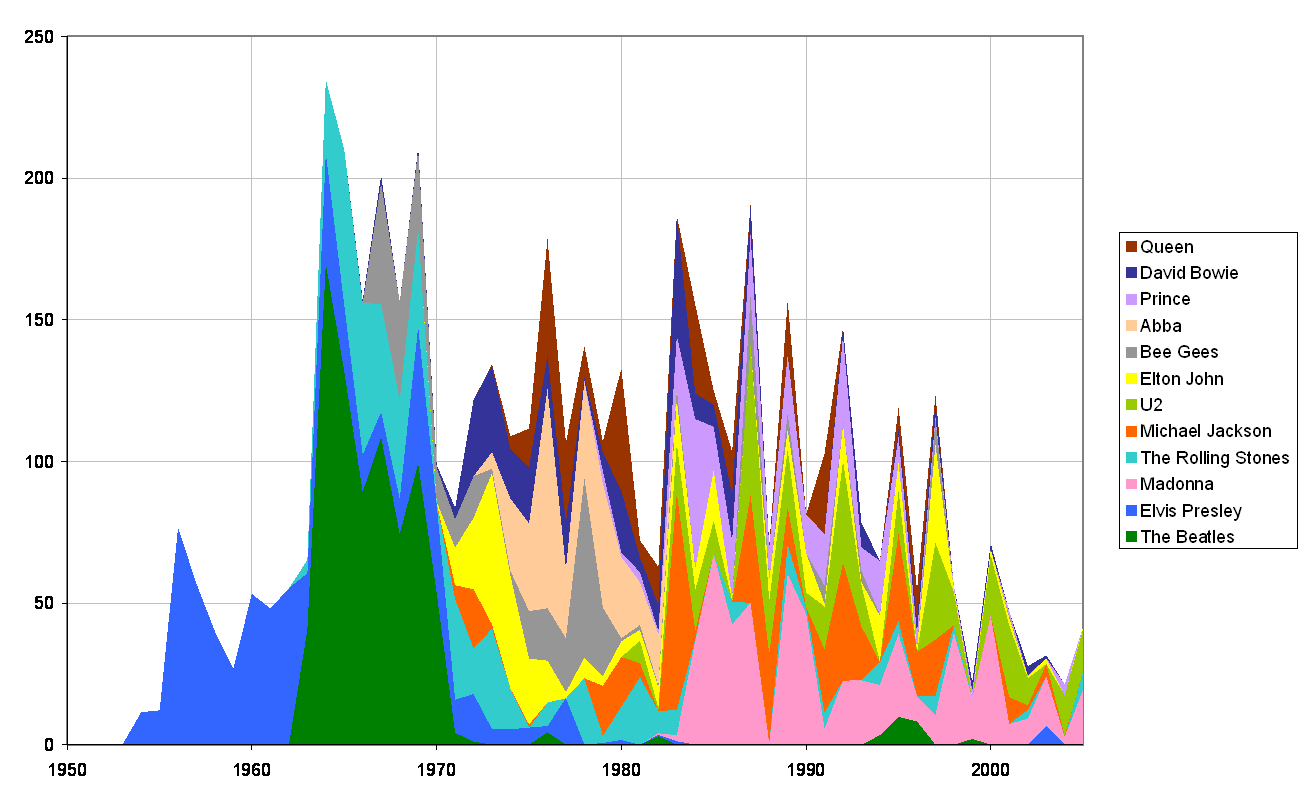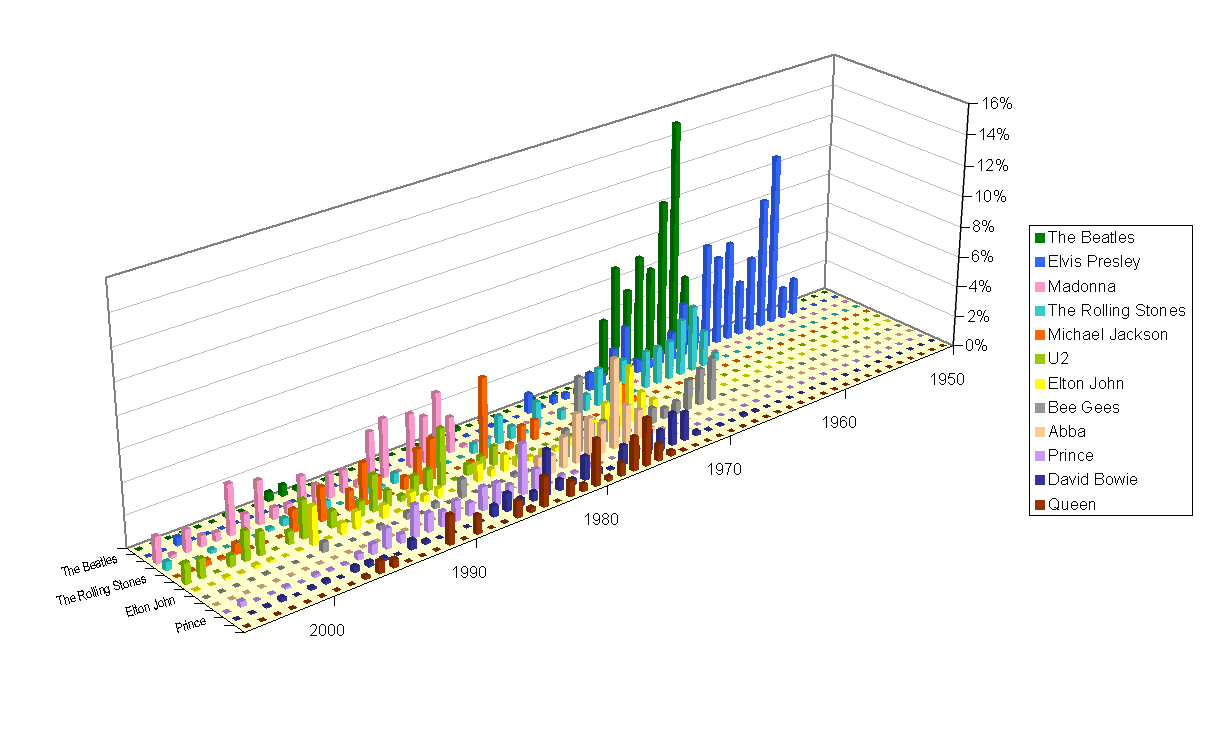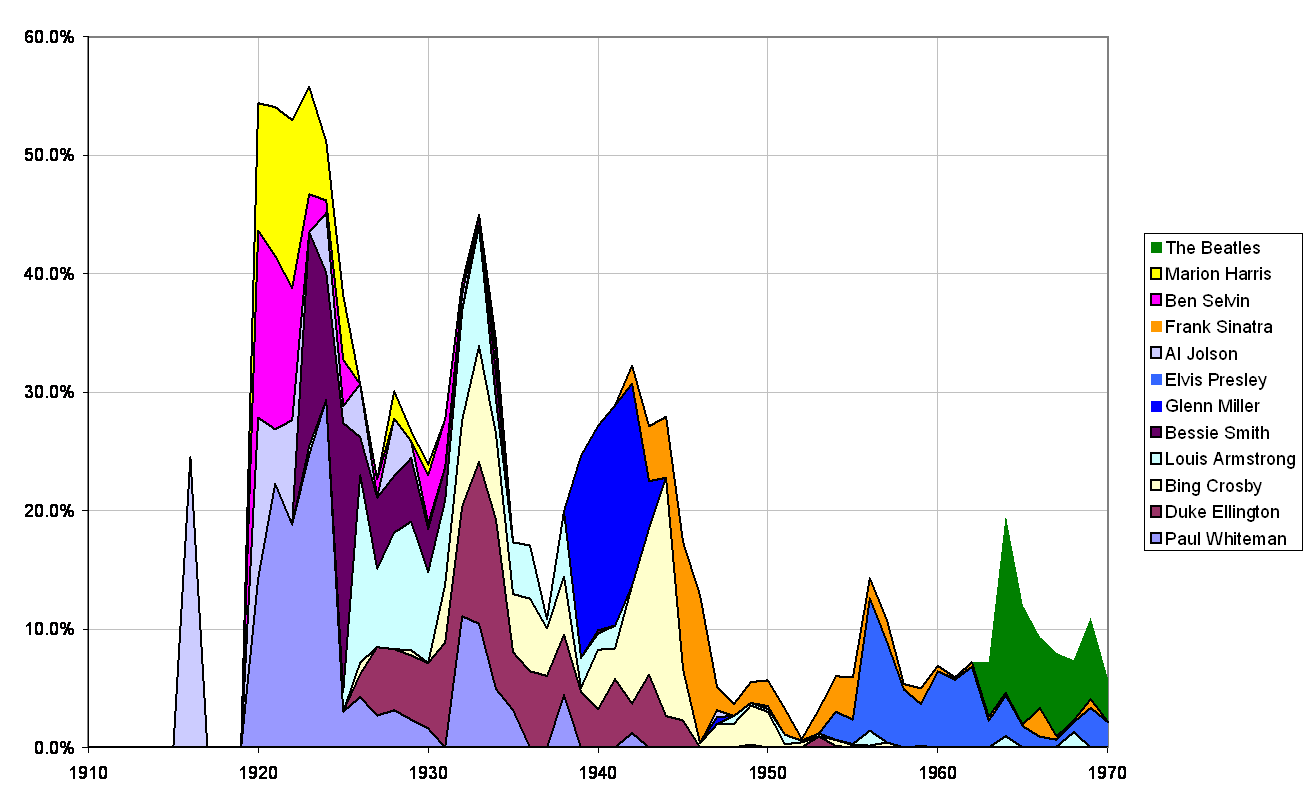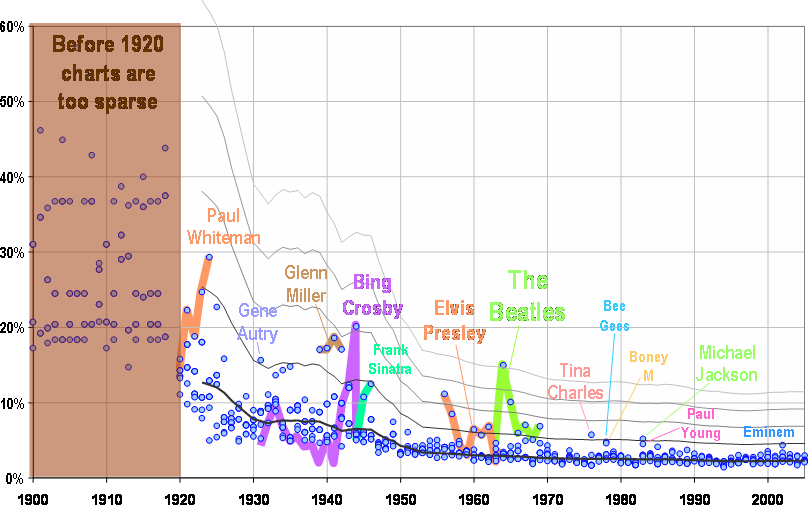 |
| Music |
| Songs |
| Song Years |
| Song Artists |
| Song Titles |
| Song Charts |
| Albums |
| Album Years |
| Album Artists |
| Album Charts |
| Site Index |
Who was the greatest song chart act of all time? |
|
When comparing the success of individual songs it is important to uncouple the influence that the number of available charts has on the result. If we are comparing the annual performance of each artist against their contemporaries then much of this bias can be smoothed out, because the values are generated from the same set of charts and the bias that comes from the different territories has been removed. However, when looking at the overall career of an artist spanning a number of years a better way to remove the bias has to be found. One way to do this for songs and albums is to use an artist's annual positions. That approach tells us which artist did best over a range of years, but it takes no account of how impressive chart success was in any one year. It is also worth exploring another approach.

The plot above shows the annually accumulated score for the top artists. This gives an impression of the trends but, the varying number of entries in each year prevents real comparison across the years.

A better comparison is to look at what percentage of the total available score for a year each artist managed to get. This plot shows how much more impressive the achievement of The Beatles and Elvis Presley was than that of more recent chart toppers.

When this same approach is taken for years before 1930 the small sizes of the historic charts dominates the result. This display emphasises acts that did well in the earlier years when few charts are available. Did Paul Whiteman really do so much better than Bing Crosby?

So here is the picture that really tells the story. First of we calculated the percentage of the available score for each year that the artists obtained. Then we took the top 5 artists for each year and plotted them. We used some probability theory to estimate the spread of scores that would be expected based on the number of entries in each year's charts (shown as the contour lines). So the position of each point relative to the contours shows how impressive that achievement is. Finally we labeled the key artists.
This output shows that the outstanding popular musical achievement of the 20th century was The Beatles 1964 results. Followed by Elvis Presley's year in 1956. From this analysis the top six chart acts can easily be placed in order, they were:
| Position | Artist | Peak Year |
| 1 | The Beatles | 1964 |
| 2 | Elvis Presley | 1956 |
| 3 | Glenn Miller | 1941 |
| 4 | Bing Crosby | 1944 |
| 5 | Paul Whiteman | 1924 |
| 6 | Frank Sinatra | 1946 |
The remaining acts have not been listed since the order would depend too much on the details of how the final scores were calculated. There are a number of alternate listings on this site that expand this set.
As with all the complex calculations described on the site you can decide to try a different approach. If your analysis shows something interesting tell us about it.
Previous Comments (newest first)
13 Jun 2016
ed sheeran
Other opinions are also available
9 Apr 2010
Boy George+
Do you happen to have an idea what songs Boy George did Solo that charted in the UK, i was hoping that you had one done for him. I saw the complete Culture Club and was amazed by the chart figures you all found. I was looking for The Crying Game and Everything I Own by Boy George
In the list of all song artists Boy George is at position 1037, so he only just misses the 1000th position cut-off. That does mean that we don't have a special artist page for him.
We do, of course, have all the data. Given the limitations imposed on messages and replies we can't make it look pretty, but here it is:
|# | artist | name | year | type | score | notes|
|1 | Boy George | Everything I Own | 1987 | Song | 13.361 | UK 1 - Mar 1987 (9 weeks), Norway 1 - Apr 1987 (10 weeks), Eire 1 for 2 weeks - Mar 1987, Europe 1 for 2 weeks - Apr 1987, Belgium 2 - Mar 1987 (10 weeks), South Africa 2 of 1987, Holland 3 - Mar 1987 (12 weeks), Sweden 8 - Mar 1987 (4 weeks), Switzerland 8 - Apr 1987 (11 weeks), Germany 10 - Apr 1987 (2 months), Austria 12 - May 1987 (4 weeks), Italy 25 of 1987, Poland 28 - May 1987 (3 weeks), Brazil 53 of 1987, UK Silver (certified by BPI in May 1987)|
|2 | Boy George | The Crying Game | 1993 | Song | 5.661 | France 1 - Oct 1992 (2 weeks), Canada RPM 1 for 1 week - May 1993, US Billboard 15 - Mar 1993 (17 weeks), UK 22 - Sep 1992 (4 weeks), Japan (Tokyo) 36 - Apr 1993 (13 weeks), US Radio 82 of 1993 (peak 8 6 weeks), RYM 115 of 1993|
|3 | Boy George | Sold | 1987 | Song | 2.146 | Holland 18 - Aug 1987 (5 weeks), UK 24 - Jul 1987 (5 weeks), Belgium 26 - Aug 1987 (3 weeks), Italy 97 of 1987|
|4 | Boy George | To Be Reborn | 1988 | Song | 1.713 | UK 13 - Nov 1987 (7 weeks), Sweden 13 - Jan 1988 (3 weeks), Belgium 17 - Jan 1988 (1 week)|
|5 | Boy George | Love Is Leaving | 1996 | Song | 1.171 | France 7 - Aug 1997 (1 week), Italy 36 of 1996|
|6 | Boy George | Funtime | 1995 | Song | 1.057 | Japan (Tokyo) 29 - Apr 1995 (8 weeks), UK 45 - Apr 1995 (2 weeks)|
|7 | Boy George | Keep Me in Mind | 1987 | Song | 1.054 | UK 29 - Jun 1987 (5 weeks), Italy 50 of 1987|
|8 | Boy George | No Clause 28 | 1988 | Song | 1.053 | Belgium 28 - Jul 1988 (3 weeks), UK 57 - Jun 1988 (3 weeks)|
|9 | Boy George | Live My Life | 1987 | Song | 1.041 | US Billboard 40 - Dec 1987 (11 weeks), UK 62 - Mar 1988 (3 weeks)|
|10 | Boy George | Don't Cry | 1988 | Song | 1.027 | UK 60 - Oct 1988 (3 weeks), Italy 98 of 1988|
|11 | Boy George | Bow Down Mister | 1991 | Song | 1.026 | Poland 49 - May 1991 (1 week), RYM 182 of 1991|
|12 | Boy George | Il Amore | 1995 | Song | 0.520 | UK 50 - Jul 1995 (2 weeks)|
|13 | Boy George | Same Thing In Reverse | 1995 | Song | 0.518 | UK 56 - Oct 1995 (1 week)|
|14 | Boy George | Don't Take My Mind On A Trip | 1989 | Song | 0.515 | UK 68 - Mar 1989 (3 weeks)|
|# | artist | name | year | type | score | notes|
|1 | Boy George | Sold | 1987 | Album | 3.269 | Switzerland 15 - Jul 1987 (2 weeks), Norway 15 - Jul 1987 (4 weeks), Sweden 18 - Jul 1987 (9 weeks), Italy 22 of 1987, UK 29 - Jun 1987 (6 weeks), UK Silver (certified by BPI in Nov 1987)|
|2 | Boy George | Cheapness & Beauty | 1995 | Album | 0.523 | UK 44 - Jun 1995 (1 week)|